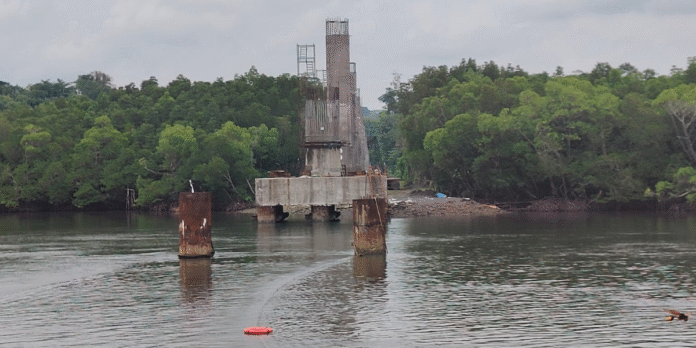Sri Vijaya Puram, July 4: The construction of the 1.96-kilometre-long Middle Strait–Baratang Bridge, a critical link on National Highway 04 (Andaman Trunk Road), has reached 25% completion. While foundational work shows visible progress, the project continues to face delays, with the revised completion deadline now set for February 25, 2026.
The bridge, which crosses the Middle Strait Creek, is expected to significantly ease travel between South Andaman and Baratang by replacing the decades-old ferry system. Once operational, it will reduce travel time by nearly 45 minutes, offering uninterrupted, all-weather connectivity across the Andaman Islands’ main transportation corridor.
Work officially began on May 7, 2024, after RKC Projects Limited was awarded the contract for ₹208 crore (INR 2.08 billion) through a retendering process. The move came after the previous contractor was terminated in June 2023 for non-performance, an issue that had already stalled the project, which initially launched in 2019.
According to a senior official overseeing the project, critical groundwork such as retaining walls, breast walls, and drainage systems has been almost completed.
However, progress on the main bridge structure has slowed due to delays in obtaining forest clearances, inaccessibility of construction materials, and adverse weather conditions, particularly during the monsoon season. Authorities have stated that full-scale construction will resume once all necessary regulatory approvals are secured and site conditions become more favourable.
The Ministry of Road Transport & Highways (MoRTH) and the Andaman & Nicobar Administration are jointly monitoring the project to ensure adherence to the updated schedule and to avoid further setbacks.
The ongoing dependence on ferry services has caused frustration among regular commuters. Ramesh, a bus driver transporting passengers between South and Middle Andaman, shared the challenges they face. “We sometimes wait for hours at the jetty, especially during bad weather. Many of my passengers are elderly or schoolchildren, and the long wait makes them restless. The bridge will make travel quicker and more reliable,” he said.
Tourism operators have also been affected. Shiva Kumar, a cab driver who regularly transports tourists to Baratang’s popular limestone caves and mud volcanoes, noted the pressure the ferry system puts on daily schedules. “During peak season, we have to leave by 3 a.m. to make it on time. Many tourists complain about delays and long queues. A bridge would mean more trips, happier customers, and more income for us,” he said.
Seen as a major infrastructure upgrade for the islands, the bridge is expected to improve not just daily travel but also support tourism, emergency response, and freight movement across the North and Middle Andaman regions.
With increased government oversight, funding support, and a quarter of the work already completed, officials and locals remain cautiously optimistic that the long-delayed Middle Strait–Baratang Bridge will soon fulfill its long-promised goal of providing reliable, round-the-clock connectivity.



